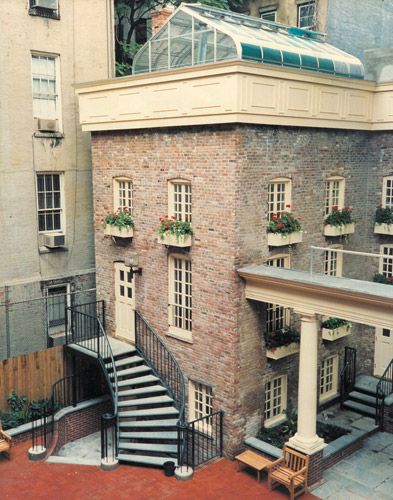Location, location, location (and other details)
Note: This post is full of links to other really interesting websites. Each link opens a new window. Enjoy exploring!
The setting of a play can be as detailed and exact as the playwright, the director and/or the producer want or need it to be. In the musical The Fantasticks, which has the feeling of a parable, the setting is a nearly bare stage with a trunk and a ladder. In Larry Shue’s The Foreigner, the single large hunting lodge set (which needs to include a trap door) benefits from a loving attention to realistic detail. [NOTE: both this excellent shows are running right now in Fort Wayne, at IPFW and First Presbyterian, respectively.]
Jeannette Clift George sets her two-character play, Interval, in the heart of New York City, Manhattan. Perhaps because for Americans, NYC is the quintessential Big City, it is a fitting backdrop for a play about two lonely people who are having a hard time finding a place to belong. Audience members who know New York well may have a bit of a job suspending disbelief that there could actually be a “forgotten corner” of Riverside Park, which runs along the Hudson River. We have tried to suggest that it is a sunken section of garden (steps down from street level).
You will notice several things about this garden:
–No flowers, only perennial evergreen shrubs, and some wildflowers in April
–a telephone booth. We don’t see those too much any more, but this is the 1980s, before everyone had a cell phone. You’ll also notice that it’s an obsolete phone with a rotary dial…this park really is neglected! [To see a charming children’s book about a (real!) “lonely phone booth” in New York City, click here.]
–a park bench
–a trash can that never gets emptied (except by Alan in the play)
–a variety of wall treatments around it, as though the contractors were using up leftover stone.
We will indicate the seasons changing with changes in lighting. 5:15 on Friday is the time in nearly every scene, but 5:15 PM in January looks much different than in March or June. Watch for the shifts in angle and intensity. Of course the actors’ costumes will also reflect the season, temperature and weather conditions. Sound effects will reinforce these, too.
Lenore and Alan mention several other places in NYC, which you might be curious about:
 1. Lenore works at the Hartley Club, which she described as a “posh women’s residence club, like the Junior League with apartments.” For those not familiar with the Junior League, it is (quoting its website): “an organization of women committed to promoting volunteerism, developing the potential of women, and improving communities through the effective action and leadership of trained volunteers.”
1. Lenore works at the Hartley Club, which she described as a “posh women’s residence club, like the Junior League with apartments.” For those not familiar with the Junior League, it is (quoting its website): “an organization of women committed to promoting volunteerism, developing the potential of women, and improving communities through the effective action and leadership of trained volunteers.”
In researching such clubs, we discovered that there actually is a Hartley House, founded in 1897 to serve the community known as Hell’s Kitchen, and still active today. Its facilities include a theater, formal dining rooms and courtyard. It may be that the playwright was paying homage to this organization by using the name in her play to designate a fictitious club on Park Avenue.
2. Lenore mentions that she plans to experience Chock full o’Nuts, which is a well-known chain of coffee shops with a very interesting history: William Black opened a nut shop in 1926, at the corner of Broadway and 43rd St. During the Depression, when nuts were a luxury, he converted his shop to an inexpensive coffee and sandwich shop. Since then, Chock full o’Nuts has become the official coffee of a number of different NY organizations. If you click the link, you can view a very informative and entertaining 3 minute video about its full history.
3. Lenore brings Alan some candy she calls “French Lace”. “It’s chocolate,” she says. Boy, did we have a time tracking this down! I did finally find a candy known as French Lace: fine caramel drizzled in a pretty pattern, hardened, then dipped in chocolate. It was a Russian recipe, brought to this country and sold exclusively by a New England confectioner. Eventually it was sold to Hauser Chocolatier, which still sells several varieties. I suspect the playwright was looking for something really out of the ordinary. Lenore also mentions that it comes from “Colbert’s”… In fact there is no chocolatier called Colbert’s in New York, but there is a very exclusive international chocolatier with shops there. It is called La Maison du Chocolat. It is one of a consortium of about 75 luxury businesses overseen or owned by Comite Colbert. Aha!
Although La Maison du Chocolat does not in fact sell French Lace, it is obtainable online from Hauser’s. However, it is horribly expensive. Our commitment to verisimilitude on a budget led us to another fine chocolate-covered caramel product:
The work of a dramaturg is a little like that of a detective.

